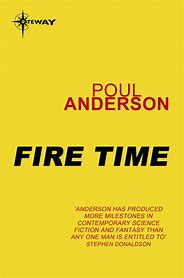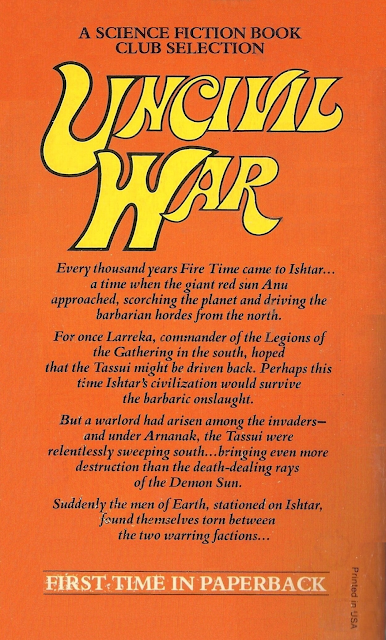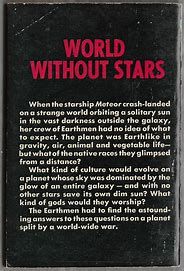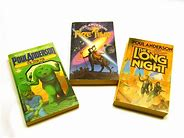Friday, 31 May 2024
Closer And Later Perspectives
Yuri Dejerine And Donald Conway
Fire Time, II.
This chapter provides future historical background details.
Dejerine listens to Gean music and was stationed on Gea. We remember that Gunnar Heim was born and grew up there.
Dejerine converses with Donald Conway who grew up on Ishtar.
They are in Lunar gravity because they are on the Moon before shipping out to their respective war postings.
The current war is against Naqsa. Naqsans were introduced in The Star Fox.
Conway refers to the Aleriona affair which was thirty years before. A generation and a half have elapsed.
Dejerine refers, of course, to the World Federation Peace Control Authority and also to the Kenyan Empire which had been mentioned in The Star Fox.
The chapter also presents tables of data about the Anubelean System which I do not feel like going into right now. This is genuine future historical writing, albeit in only two volumes: build on past information and add more in each new instalment.
Leading An Attack
Fire Time.
By the end of Chapter I, we know that Arnanak and his Tassui are tailed and quadrupedal. Leading an attack:
"He trotted into a run. Behind him the ground drummed under the weight and haste of his warriors." (I, p. 14)
By a slight mental effort, we must remind ourselves that these warriors and their leader are neither bipedal infantry nor cavalry but centauroids. They trot, then gallop, on all fours. That has implications for their society which Anderson will spell out as the novel proceeds. To our relief, after dauri and centauroids, we find that Chapter II is about human beings. Yuri Dejerine, named with a miss-spelt first name in the blurb on p. i, makes his entrance/ comes on-stage.
Dauri II
Fire Time, I.
Almost immediately, we start to learn about the dauri but what we learn remains puzzling. They have petals. They are said to "haunt" (p. 11) the Starklands where they have a "tomb city" (ibid.) Arnanak, a leader among the Tassui, has travelled into the Starklands:
"'...where never mortal trod before...'" (ibid.)
Thus, Arnanak confirms the implication that these mysterious beings are not mortals - and therefore are immortal? He has befriended the dauri and has brought from their tomb city "'...a Thing of Power.'" (ibid.)
- which remains undescribed but which he displays to his followers as a sign that they will conquer. Seven dauri have accompanied him and it is their leader that carries the Thing beneath its petals so that Arnanak, taking it, can hold it aloft, displaying its partly gleaming and partly black surface. An unfamiliar artefact that can be used as a talisman? If this were fantasy, then the dauri might be elves.
Dauri
We read a passage like the opening paragraph of this chapter accepting that we do not yet understand some of the terms used but trusting that all will be made clear as we proceed. Poul Anderson slips something right past us. In Fire Time, the Demon Sun blazes above the Starklands where no mortals live even at the best of times. Southward from these Starklands dwell the Tassui who therefore are the northernmost of mortals. This is all clear so far.
However, "Dauri" from the Starklands travel south on unknown errands and thus come among the Tassui. Presumably these errands are unknown to mortals, not to the dauri themselves. So the dauri are not mortals? Then who or what are they? Not only are we not told yet. At a first reading, we probably read right past this first paragraph without noticing the strange status of these dauri.
Centuries Agone
Human And Alien
The Judge And His Servant
Fire Time, FOREWORD.
We can extend the comparison between Judge Daniel Espina and Guion. Both characters appear in framing devices. Espina tries to discern the subjective factors that motivated mutineers and thus made a slight change to history whereas Guion tries to discern the subtle factors that might change history in a mutable timeline.
There are two points about Espina's servant. The first has been made before. He is nonhuman but is not described so that film makers or graphic artists would have carte blanche about his appearance and no doubt would create very different versions. Secondly, maybe it is good that he is not described. We are spared yet another account of a humanoid form with longer legs, no external ears or a different number of fingers etc. Maybe for once it is better just to leave it that he is not human.
Thursday, 30 May 2024
Human Beings And Ishtarians
Fire Time.
The blurb on p. i tells us that Jill Conway and other human beings in Primavera want to help the civilized centauroids against the northern barbarians but that Captain Yri Dejerine thinks that all the resources in Primavera should be devoted to the interstellar war. Should Primaverans betray Earth or their Ishtarian friends?
The back cover blurb tells us that, when the red sun, Anu, scorches Ishtar, the northern barbarians move south, this time led by a new warlord, Arnanak. Larreka, commander of the Legions of the southern Gathering hopes to drive them back and this time preserve civilization. Earthmen on Ishtar are torn between two sides. At least that is what the blurb says.
Thus, the two blurbs present human and Ishtarian points of view, respectively. And that is all from here for now. I have been watching the news from another part of Earth with interest...
FIRE TIME, FOREWORD
Fire Time, FOREWORD.
A judge, Daniel Espina, has asked for a private interview with some self-confessed mutineers whom he must sentence. Like Guion, who interviews Manse Everard and Wanda Tamberly in the same author's The Shield of Time, Espina seeks something more subtle than another bunch of data. He wants to know how something feels. His request to the mutineers leads into Chapter I of the novel.
Espina is a good guy trying to understand a difficult situation. He is comparable to Guion but contrasts sharply with various characters in Frank Herbert's Dune series who engage in personally nasty power conflicts at the top of their society. We do not know what it is like to live in that society. Espina lists some of the kinds of "mankind" in the World Federation:
Chill In The Spirit
Fire Time, FOREWORD.
The two opening paragraphs are an extended pathetic fallacy. The first three sentences describe the impact of a man:
FIRE TIME: The Ballantine Edition II
Fire Time.
Continuing our appreciation of a particular edition of Poul Anderson's Fire Time, we now display its back cover.
Usually, we just discuss the content of a novel. This content is like a Platonic Idea. It can be instantiated in an unlimited number of different editions, in translations or on audiotape and we might think that the content is accurately reproduced in an adaptation to a different medium. (Usually not.)
Any given edition is one instantiation of the content and in turn is instantiated in multiple copies. So I possess one copy of one edition but we never encounter the content in the abstract, uninstantiated. That maybe existed in the mind of its author/creator who is no longer with us.
In the Ballantine Books edition, the text covers pp. 1-246 and is followed by two pages of information about other books published by Ballantine. Between "FOREWORD" (pp. 1-5) and "AFTERWORD" (pp. 241-246), there are twenty-four chapters, on pp. 7-240, and they are headed I-XXIV. There are no "Parts" or "Books."
OK. All that remains is to reread the novel!
FIRE TIME: The Ballantine Edition
Poul Anderson, Fire Time (New York, 1975).
We can begin by appreciating the physical artefact of a book in our hands. I am holding a Ballantine Books edition of Fire Time. See image.
First, a cover illustration that indicates either fantasy or sf.
Secondly, the front cover blurb: "A big, bold novel of interplanetary conflict and intrigue!" The publisher could have added: "Assuming that that is your idea of a good time, of course..." How many potential readers will be instantly warned off by that single word, "interplanetary"?
Inside the front cover: maps of the Anubelean System and the planet, Ishtar.
Inside the back cover: map of the Gathering of Sehala. (We are not supposed to know what this means yet and will probably not have looked this far ahead, in any case.)
Returning to the beginning but then glancing ahead, we find that the text commences, very properly, on page 1. Between the cover and page 1, there are eight unnumbered pages which we can enumerate as pp. i-viii.
p. i is three paragraphs of blurb introducing some of the characters and their setting.
p. ii lists two other titles on the Ballantine Books list, Brain Wave and A Midsummer Tempest. We reflect on how dissimilar these three works are, almost as if written by different authors:
A Midsummer Tempest is a fantasy novel set in an alternative seventeenth century, is a sequel to two Shakespeare plays and connects with other alternative historical fantasy works by Anderson;
Brain Wave is near future sf about a change in human nature;
Fire Time, set in an interstellar future, is a sequel to The Star Fox, although perhaps readers do not realize this yet.
p. iii is the title page (almost like an inside cover).
p. iv is publication information.
p. v is the dedication "FOR HAL CLEMENT, worldsmith". (Adzel studies at the Clement Institute in Anderson's Technic History.)
p. vii is blank.
p. 1 is the beginning of "FOREWORD" and that is all from me this lunchtime!
Similar Thoughts In Alternative Universes
Wednesday, 29 May 2024
Fantastic Inns And The Earth Book
The Flying Inn by GK Chesterton is so old that Lancashire Libraries have one copy "on reserve" and it will take a couple of weeks for it to arrive here. It has some good cover illustrations. I requested this book because its title suggested that it might be about a fantastic inn comparable to Poul Anderson's Old Phoenix or Neil Gaiman's Inn of the Worlds' End. However, further research suggests that the novel is not about an inn let alone a flying one so that, when it does arrive, I might not be interested enough to read through it.
Meanwhile, it has occurred to me that the five volumes that precede Anderson's The Earth Book of Stormgate contain six stories and two novels about the Polesotechnic League and one novel about Ythrians whereas the Earth Book contains seven stories and one novel about the League and four stories about Ythrians so that this single volume is as substantial, or nearly so, as its five predecessors. As some blog readers might realize, I never tire of repeating how profound a future history series Anderson's History of Technic Civilization is.
More About Languages
The Star Fox.
There is a big difference between some knowledge of another language and none. The Star Fox includes not only untranslated French but also untranslated German. Before his river escape, Heim says, in the hearing of his captors but for Vadasz's benefit:
"'Wenn wir sind an der Fluss gekommen, und im Falls wir die Moglichkeit sehen, dann werden wir ausspringen und nach dem Haffen schwimmen.'" (p. 185)
Something about coming to the river...jumping in and swimming? We learn what he does when they reach the river even if we understand little or nothing of what he has said beforehand. (Sheila, a German scholar, has just translated the sentence for me.)
Later, Vadasz must radio the New Europeans in a language not understood by the Aleriona. He does not know Basque but might use Louchebeme. The first time that I read this book I would just have had to pass by "Louchebeme" but now we can google it here.
Novelists usually just render all dialogue in English even if we are to understand that the characters are really speaking something else but maybe they could somehow further the appreciation of other languages if only by presenting some French or German etc dialogue and translating it in footnotes as CS Lewis does with a short Latin exchange in That Hideous Strength?
THE STAR FOX: Conclusion
Heim rams one Aleriona spaceship with another. Fox II liberates New Europe. Earth defeats Alerion. Heim settles on New Europe which declares independence from the World Federation. Heim spells out the usual Andersonian moral that mankind needs diversity, also adding that isolated, self-sufficient planets have nothing to fight about. When it is pointed out that there has just been an interstellar war, he replies that that was precisely because someone had tried to hinder human development. However, there will be another war for other reasons in the sequel. Do American sf writers find it difficult to stop writing about wars? Sometimes trade replaces war as the main interstellar interaction and two Andersonian short stories describe the peaceful biracial colonization of Avalon.
Typical quotes:
"'The universe is too big for any one pattern. No man can understand or control it, let alone a government.'" (The Star Fox, p. 205)
"'Let's find out how many kinds of society, human and non-human, can get along without a policeman's gun pointed at them. I don't think there is any limit.'" (ibid.)
And the passage that provides a title:
"'We're lying the foundations of' - he hunted for words - 'admiralty. Man's, throughout the universe.'" (p. 207)
Several Andersonian futures point in the same direction.
Time And Age
Tuesday, 28 May 2024
What Heim's Men Were Doing On The Moon, Diane
The Star Fox, Part Three, IX.
OK. In this chapter, on pp. 194-195 in my edition, we are told what Heim's men were doing on the New European moon, Diane. It is technical and I am not going to try to summarize it at this time of night but it has to do with a communication relay system, a Lagrangian point and using Diana to conceal Fox II from the Aleriona on New Europe. We are nearly finished The Star Fox, have found discussion points that we had not found before and next will reread the sequel, Fire Time, but will not start into it tonight. There is some other rereading of interest and I am still trying to give the Dune series a chance.
Heim In A Foxhole
The Star Fox, Part Three, IX.
Gunnar Heim:
"Please...let me live that long. I don't ask for more. Please, Fox has got to be told." (p. 194)
See "There are no atheists in foxholes," here.
Heim offers a foxhole prayer. We can all do this. It is the old pagan/agnostic prayer to "whatever gods may be" and does not prove that we are all covert monotheists. The prayer of monotheist faith is not just said in foxholes and is a different matter entirely. My closest approach to it is zazen meditation because I do not believe that reality is or can be a person to be addressed in verbal prayer. But, whatever the reality is, we are all in it.
Do novels always raise ultimate philosophical questions? I think so, as long as their characters reflect and/or pray.
The Wisdom Of Vadasz - And Heim
The Star Fox, Part Three, VII.
Again Vadasz to the Aleriona:
"'Humans live mostly for their children...'" (p. 185)
Is that true? Some people do not have children. Those who do adopt very different attitudes to them and, usually, lead a life separate from parenthood in any case. My attitude to my single daughter has been the opposite of my parents' attitude to myself and my two sisters but let's not go into that!
In any case, Vadasz is feeding a line, or a lie, to the Aleriona whether or not he believes it himself.
Heim leans over a river:
"'Here's a basic human symbol,' Heim said. 'A river, bound to the sea, bound to flood a whole countryside if you dam it. Motion, power, destiny, time itself.'" (p. 186)
Now this we can wholeheartedly agree with this. We remember the Time Patrol. A river is a powerful symbol of life and history.
But Heim has a pragmatic motive. Despite the armed guards at his back, he plunges his captor, Cynbe, and himself into the river... An Andersonian escape.
Laws Unto Ourselves?
Monday, 27 May 2024
Interstellar Conflicts
If there are no other technological civilizations, then they are impossible.
If there is no FTL, then they are improbable.
If there is no FTL and if technological civilizations are rare, then they are improbable verging on impossible.
What would there be to fight about over such distances?
The Ai Chun in Poul Anderson's World Without Stars and the Aleriona in his The Star Fox have very old static cultures and are genetically incapable of tolerating engulfment by a younger, dynamic species. The Alori in Anderson's The Peregrine have an organically based culture that cannot tolerate engulfment by a mechanically oriented civilization. The Merseian Roidhunate in Anderson's Technic History is racially supremacist and cannot tolerate any species that remain independent of it.
In James Blish's future histories, there are mainly imperialistic relationships between interstellar civilizations. In one branch of his Haertel Scholium:
French Conversation
Some short passages of dialogue are in untranslated French. I can understand some of it, e.g.:
"'La nuit, le jour, c'est la meme chose pour les Neo-Europeens.'" (p. 171)
(Night and day are the same for New Europeans.)
However, it is a scandal that I cannot speak French fluently. From 1961 to 1967 in a boarding school in the Republic of Ireland, we were "taught" Latin, French and Irish - expect that we gained no ability or fluency in any of them. But then that was not regarded as necessary in the life styles for which we were being prepared. They must have improved teaching techniques since then. If I were to be put through that schooling again, then I would try to gain some proficiency in all three languages but, like most of us at that age at the time, I was incapable of seeing it that way while we were being force fed "subjects" called "French" etc. What a waste of time and opportunity.
Back To The Technic History
New European Trees
The Star Fox, Part Three, VI.
On the human colony planet, Europe Neuve:
"...everywhere trees, Earth's green chestnut and poplar mingled with golden bellefleur and gracis." (p. 173)
This is like a microcosm of the mixed ecologies to be found in Poul Anderson's Technic History, e.g.:
Sunday, 26 May 2024
The Campaign
The Star Fox, Part Three, I.
Parts One and Two have led up to Gunnar Heim privateering in Fox II. At the beginning of Part Three, he summarizes Fox II's record to date:
"'Four months of commerce raiding, eighteen Aleriona ships captured, and we haven't had to kill anyone yet.'" (p. 140)
But then something happens that brings the campaign to an end! So the narrative has skipped past nearly all of the campaign, those four months and eighteen ships captured. An entire "interquel" sub-series could have been inserted between Parts Two and Three. But I would not want it to be written by anyone other than Poul Anderson.
Not three years but four months and we don't see them! But there is a sequel, Fire Time, but that is different. Poul Anderson confounds expectations. Alan Moore said that a good writer gives his audience not what they want but what they need - and they prove him right by continuing to read.
The Meteorite
The Star Fox, Part Three, V.
I have read to the end of this chapter but still do not get it. It was Fox II that had grappled and towed the meteorite. This meteorite had to be:
The Mission To Europe Neuve
The Star Fox, Part Three, III.
I am not fully following something but maybe that is because I have not read far enough yet but I will be going out shortly so here is the story so far. Heim wants to land himself and three others on the Aleriona-occupied human colony planet, Europe Neuve. Fox II approaches the far side of the moon, Diane. A tender descends to the surface. Its crew trek to the planet-facing side, complete their errand, whatever it is, and return, then wait in their tender.
Next, a giant meteorite hits the planet. Heim and his three companions fly down in a captured Aleriona ship, concealed and shielded by the meteorite. Heim must pilot the ship to remain exactly behind the meteorite before he veers off. They make it.
Did the men who went to Diane cause the meteorite to hit the planet? How? Have I just not read far enough yet? I will report back later.
Valhalla And The Worlds' End
The Star Fox, Part Two, VII.
Gunnar Heim:
"'I'll hoist a beer with you yet.'" (p. 128)
Endre Vadasz:
"'If not on ship...then in Valhalla. Farewell.'" (ibid.)
We will not go to Valhalla but it is good to say it. In my hearing, one Catholic priest said to another, "We'll meet on the Day of Judgement if not before!" Did they believe that was literally true? (There is a contradiction between Heaven, Hell or Purgatory for disembodied consciousnesses immediately after death on the one hand and a long-delayed Resurrection and Judgement followed by Heaven or Hell for reembodied consciousnesses on the other hand. Greek and Biblical concepts have been grafted together.)
A Catholic layman wrote:
Saturday, 25 May 2024
Occupied Planets
Part Three is called "Admiralty." The original magazine version of "Admiralty" is collected in the NESFA The Collected Short Works of Poul Anderson, Volume 4, which is entitled Admiralty and has a very appropriate and evocative front cover illustration.
It is late here and other reading calls but be back here soon for Heim on Europe Neuve.
The Dog And The Wolf II
Dragon Shapes
On Staurn, one of Heim's crew and one of his antagonists die. Afterwards, he says:
"'Two good men died...'" (p. 132)
It is pointless to continue the disagreement after the separation of death.
I have checked and confirmed that the original magazine versions of all three parts of The Star Fox are reprinted in Volumes 2, 3 and 4, respectively, of the NESFA Collected Short Works of Poul Anderson so all three of those covers will be reproduced here. The sequel, Fire Time, cannot be in any of the NESFA volumes because it is not a short work.
Part Two ends:
"...he looked out. A flock of Staurni hunters was taking off. Sunlight flared across their weapons. The turmoil in him changed toward eagerness - to be away, to sail his ship again - as he watched those dragon shapes mount into the sky." (p. 135)
What a great send-off for Staurn! The Staurni appear only here unlike the Ythrians who get their own mini-series within Anderson's Technic History.
At last, in Part Three, Heim will go into action against the current enemy, the Aleriona.
Staurni Terrain
The Star Fox, Part Two, VI.
"The end of the plateau was coming in sight." (p. 116)
If the Trekkers as I call them are traversing the top of a plateau - I have not yet looked back to confirm this - then the end of the plateau must be the top of a cliff? However, the text continues:
"Between the edge and the mountain's next upward slope was an escarpment." (ibid.)
So beyond the edge there is not a descending cliff but an upward slope while between the edge and that upward slope there is an escarpment, i.e., "a steep slope or long cliff"? I am having problems with this.
The cliffs in front of the Trekkers are "...unscalable..." (ibid.) and too long in either direction to go round in the short time left to their supplies. However, in the centre, vapour roiling up the mountain from the foot of the scarp marks the spot called "Thundersmoke" where geysers and hot springs have crumbled the cliffs, making a rugged incline with water rushing everywhere across it so that is where they must go, of course, in the rest of this chapter and in our next post.
An epic journey.
Friday, 24 May 2024
Forest And Machines
The Star Fox, Part Two, V.
We have reread to the point where the Staurn Trekkers, as we might call them, cut their way through a forest only to find that it moves. See The Walking Forest. It does not attack them as I mistakenly stated before. Instead, they are simply in its way and must escape in order in order not to be crushed. This forest is neither intelligent nor even conscious. It merely pulls up its roots and puts them down again as an animal picks up its feet and puts them down again but, whereas an animal consciously approaches food or avoids danger, the forest unconsciously follows the mineral that it needs. When the Trekkers have hacked their way out, that is the end of the matter although next:
"...we've got to get past the Slaughter Machines." (p. 115)
I have not posted a great deal about these Machines (see here) (scroll down) but now they will have to wait until tomorrow.
Marching
The Star Fox, Part Two, V.
Trekking across Staurn, Vadasz sings:
"Trois jeunes tambours, s'en revenaient de guerre..." (see here);
"Rimini" (see here);
"Marching through Georgia" (see here);
"The British Grenadiers" (see here);
Syrtis and Cydonia are places on Mars. This is a future song. I also saw a reference to Cydonia as the poetic name for somewhere but now can't find it.
Because he sings marching songs:
"They reached the woods sooner, in better shape, than expected." (p. 111)
Death And Sincerity
The Star Fox, Part Two, V.
Gunnar Heim:
"'There are worse ways to die than in battle for something that matters.'" (p. 111)
Dune And The Technic History
Poul Anderson's The Day Of Their Return does convey a strong sense of the beliefs and aspirations of particular individuals in diverse Aenean ethnicities engulfed by their distinctive millenarianisms, Christian, pagan, philosophical and esoteric. Before that, in Anderson's Technic History, there had been a long sweep of history from the last days of the Polesotechnic League through the two-stage colonization of Avalon, the Time of Troubles and the early Terran Empire to the Terran War on Avalon. After that, the Flandry period includes the upheavals on Aeneas.
I feel that I am wading through desert sand in Dune but soaring with Ythrians in the Technic History.
Thursday, 23 May 2024
Gravanol And Sisyphus On Staurn
The Star Fox, Part Two, V.
On the high gravity planet, Staurn, the drugs in human medikits include gravanol and kinesthan. I cannot find kinesthan anywhere else but gravanol now exists in several fictional universes.
Walking in Staurnian gravity is a "..Sisyphus task..." (p. 108)
Parliamentarism is perhaps another Sisyphus task. Great Britain will have a General Election on the Fourth of July! This blog will NOT present regular election updates. Keir Starmer, Leader of the Opposition and probable next Prime Minister, once defended my late son-in-law, Ketlan, in court and that is all that this blog will say about any of the candidates. We trust that our trans-Atlantic cousins will have a good Presidential election later this year. Next time here I will return to The Star Fox but I am out at a meeting this evening.
Gun, Action And Staurn Trek
At the end of Part Two, III, a guy pulls a gun. OK. More of that kind of action. Chapter IV is entirely taken up with the immediate consequences. At the end of that chapter, Heim, Vadasz, Uthg-a-Kthaq and their two prisoners must start a trek across Staurn through territory that includes:
"'The Walking Forest; Slaughter Machines; Thundersmoke.'" (p. 107)
So maybe we have something to look forward to in Chapter V?
When a laser beam has slashed open a man's airsuit so that oxygen and hydrogen have mixed and exploded and blood is everywhere:
"A gruesome keening lifted from the Naqsan. 'Gwurru shka ektrush, is this war? We do not thus at home. Rahata, rahata.'" (p. 105)
And is any other comment necessary?
Wednesday, 22 May 2024
Moles And Wine On Staurn
The Star Fox, Part Two, III.
"'...hydrogen gives less energy per mole than oxygen...'" (p. 95)
I never knew that meaning of "mole" and still do not understand it.
"They flew over wine darkness, streaked with foam, until the mainland hove into sight." (ibid.)
A Homeric reference.
On Staurn, industrial civilization destroyed itself so the Staurni reverted to ancestral patriarchal households which however retained nuclear weapons that could never originally have been developed by such isolated social units.
The Staurni are flying carnivores like the Ythrians in the Technic History but hydrogen-breathers. Usually, carnivores fight rather than think but the Staurni possibly developed intelligence because they had to resist a larger, related species invading their continent. More fictional evolution.
Self-Analysis Or Lack Of It
The Star Fox, Part Two, III.
"[Heim's] bewilderment didn't last long, because he was the least self-analytical of men. He shoved his questions aside for later examination and, with them, most of the associated emotions." (pp. 92-93)
In other words, he is an Andersonian hero or, more generally, a hard sf problem-solver. This is where people differ most. When I spoke to a gym instructor about sitting with whatever comes up, including guilt, in meditation, he replied that that did not sound good and that his way of coping with his past wrong actions was just not to think about them. Can he control his own thought processes as easily as that?
A friend whom I have quoted on this blog said that there was only one past action of his for which he felt guilt and that was a "sin of omission," not of commission. Only one! If we were all to be judged, then, first, each individual would have to be judged on his own terms but, secondly, each would also have to be made aware of issues that had passed him by. A criminal character in a film years ago said, "I'm in a bad f---ing way!" That was as close as that character could come to saying anything like "Bless me, Father, for I have sinned..." He was acknowledging the consequences of his own actions and not blaming anyone else for them.
Sometimes a passage in a novel can be a peg on which to hang general reflections on life.
"You Can't."
The Star Fox, Part Two, III.
Gunnar Heim to Jocelyn Lawrie:
"'My dear... the only thing that's marred an otherwise delightful time has been your trying and trying to wheedle me into giving up the raider project. You can't. In the old Chinese advice, why don't you relax and enjoy it?' He brushed his lips across hers." (p. 92)
Heim is so right. They have resumed their relationship, at least temporarily. They are spending time together. They disagree. They have already discussed the reasons for their disagreement. There is nothing worse than sterile repetition of a disagreement especially when one party, in this case, Heim, has made it clear that he does not welcome the repetition. He is not closing his mind to any new evidence or arguments but it is crystal clear that, as things stand, no new evidence or arguments are being presented.
When someone says, "No politics," let's talk about some of the many other things in heaven and earth.
Form-Fitting Furniture And Other Futuristic Props
The Star Fox, Part Two.
Form-fitting furniture (scroll down) is another standard Andersonian futuristic prop. (Note who invented it here.) Here is another example of such furniture that we have not noted before:
"She waved him to her lounger, but he took a chair instead. Jocelyn chuckled and relaxed in the form-fitting seat." (II, p. 87)
Later, Heim does unwind enough to move to the lounger...
I suspect that I have read past some form-fitting furniture recently without stopping to make a note of it. We need to be alert at all times when rereading Poul Anderson.
Another sf writer would be able to create a narrative incorporating every such prop which also include aircars, TrafCon, autopilots and gravshafts. Earlier in this novel:
"Heim claimed his flyer at the garage and fretted while TrafCon stalled about sending him aloft. Quite a time passed before the pattern of vehicle movement released him." (Part One, II, p. 32)
"He set the autopilot for Orly..." (ibid.)
- then bathed, ate and slept while travelling.
"They went downshaft in silence to the garage, and entered his flyer..." (Part One, IX, p. 63)
Gunnar And Jocelyn
The Star Fox, Part Two, II.
(We are still with Jocelyn Lawrie's reading list.)
A dialogue between Gunnar Heim and Jocelyn could have been spoken between (some) political opponents now. She speaks first:
Tuesday, 21 May 2024
Mosunic-Lopez
The Star Fox, Part Two, II.
When a futuristic sf writer presents a list of authors that are read in the future, we expect that maybe the last name on the list is of someone that does not exist yet. Sure enough, Gunnar Heim's former friend, Jocelyn Lawrie, displays reproductions of Matisse and Hiroshige and her bookshelf holds volumes by:
On Staurn
The Star Fox, Part Two, I.
Fox II took two weeks to cross the hundred light-years to Staurn and has been there for three weeks so that only five weeks have elapsed since the end of Part One. Two men called Koumanoudes and Wong have been on Staurn for two months and they interpret. Fox II, with its crew of about a hundred, is in orbit, being fitted for war. Heim and a crew of about six are on the surface with Heim's yacht, Connie Girl, which has become an auxiliary to Fox II. Heim buys weapons from the Hurst of Wenilwain and the Aerie of Trebogir. Staurni have seven-metre-span wings and are covered in a growth intermediate between hair and feathers. This is a summary of some of the information imparted in this chapter.
Regular readers will understand when I say that blogging is being cut short by a visit to Andrea above the Old Pier Bookshop and that this evening I will join others in the Gregson Centre so that posts might be sparse for the rest of today.














































